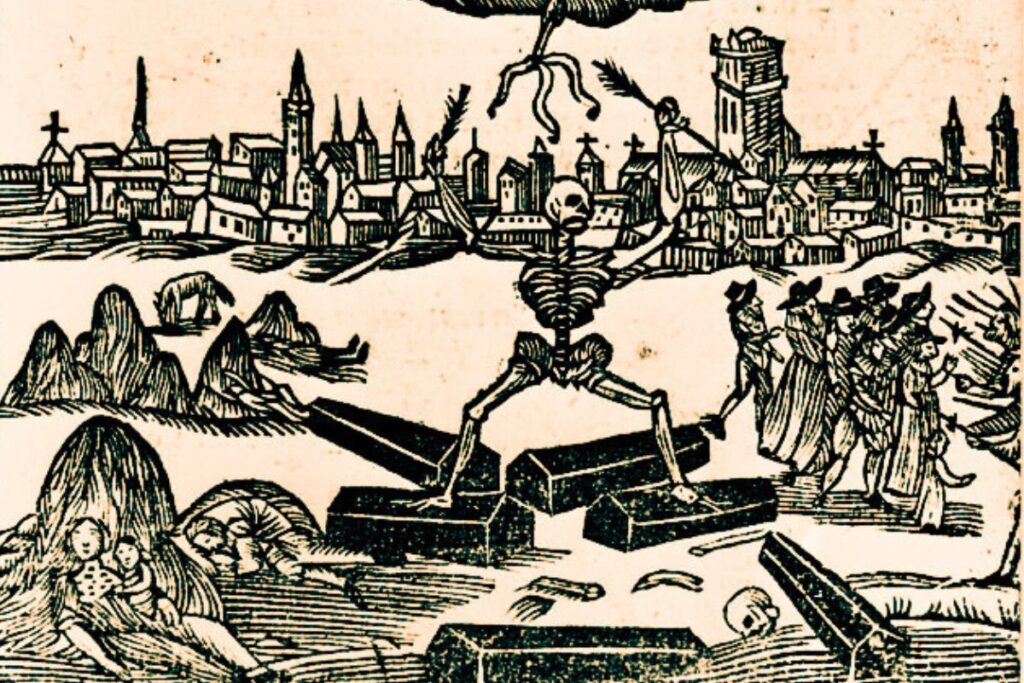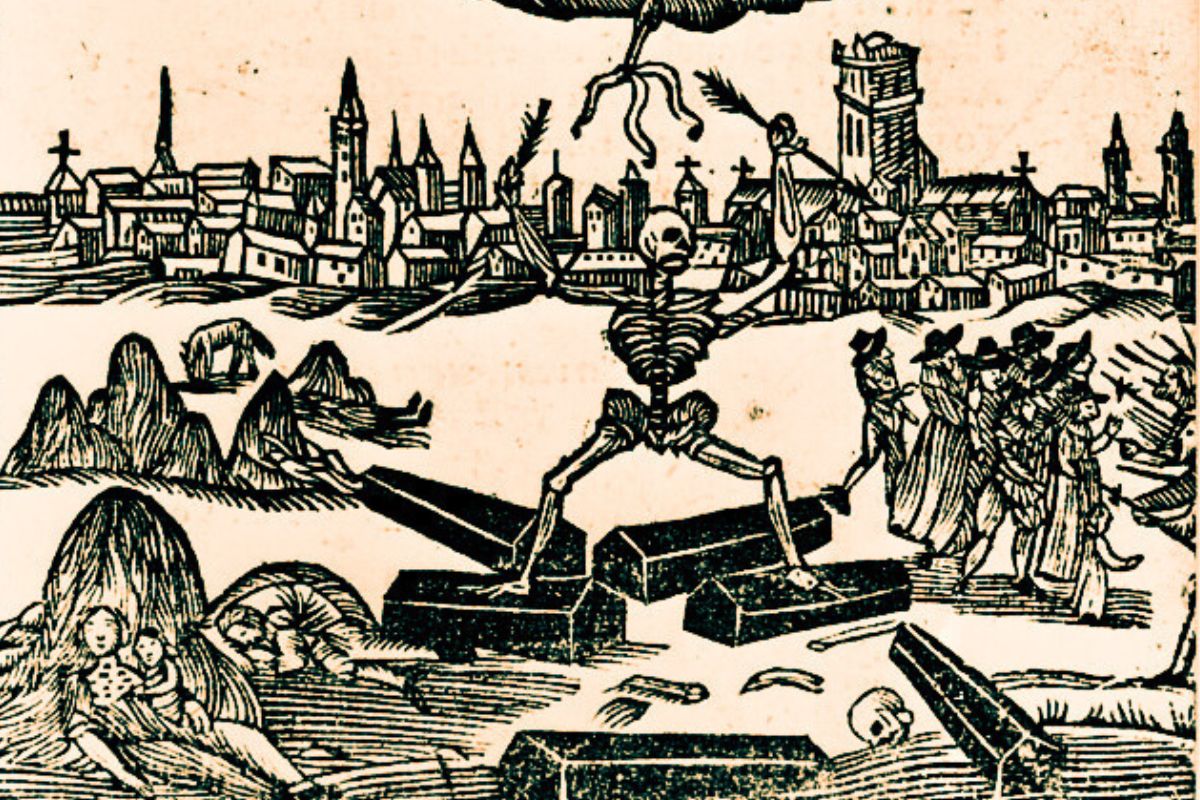London’s plague pits, dating back to the Black Death in 1348 and the Great Plague of 1665, show a grim history and recent discoveries, highlighting the city’s enduring resilience through hard times, write RICHARD CLEMENTS

In 1348, London’s first devastating encounter with the bubonic plague arrived – the Black Death. This pandemic, likely spread by fleas on rats, arrived on European shores via merchant ships and made its way to England. With London’s dense, unsanitary living conditions featuring open sewers and cramped housing, the disease found the perfect breeding ground to proliferate uncontrollably. Around a third of the city’s population, upwards of 30,000 people, perished in agony from grotesque symptoms like fever, vomiting, and egg-sized buboes.
The dead vastly outnumbered gravediggers, leading city officials under the young King Edward III to hastily designate areas like the grounds of the Cistercian abbey at East Smithfield as temporary “plague pits” to dispose of the mounting corpses. As one witness described, “It was a hideous task casting the bodies into these pits, falling in themselves with the earth they threw over so that it became necessary to have boys with pickaxes to open up space by shaking the bodies down.”
The Great Plague of 1665
Over 300 years later in 1665, the Great Plague brought renewed horror to London after likely arriving via Dutch shipping vessels. This outbreak was the bubonic plague, transmitted by flea bites, but evidence suggests it may also have been the pneumonic plague – an even deadlier airborne strain spread through coughing and sneezing.
With knowledge of disease transmission and prevention still primitive, unheeded measures like shuttering infected households and carrying herbs for protection utterly failed to stem the contagion’s tide. Around a quarter of London’s population, over 100,000 people, succumbed in just two years as mass graves were once again rapidly filled in any available open space including the windswept fields outside the city walls.
Author Daniel Defoe provided one of the few firsthand accounts, describing the grisly Aldgate pit as being “about 40 feet in length and 16 feet broad…dug near 20 feet deep.” Another contemporary noted, “Dead cart loads continually passing to and fro for interring of the dead, whose numbers could not be contained in the ordinary grave grounds.”
The Pits Resurface
As centuries passed and the medieval plagues faded from memory, the locations of the hurriedly dug pits were slowly forgotten and built over by an ever-expanding London. It wasn’t until modern construction and infrastructure projects began unearthing human remains that the public was reminded of this hidden graveyard underfoot.
During excavations for London’s new Crossrail system between 2013-15, thousands of skeletons were uncovered providing valuable insights into life during the plagues through analysis of DNA, bone pathologies, and burial positioning. The most significant find was a 16th-17th century pit at Liverpool Street holding around 30,000 remains, while another at Charterhouse Square in Farringdon may contain upwards of 50,000 Black Death victims.
Construction of early Underground lines in the 19th century also unearthed several pits during tunnel excavations, including finds at Liverpool Street, Farringdon, and Aldgate stations. In some cases, the tunnels were carefully re-routed to avoid disturbing the graves, while in others the remains were exhumed and reburied.
Other lesser-known pits have been found during various building projects and public works like the 2023 discovery of a 17th-century pit beneath Pitfield Street housing estate in Hoxton or the corpses uncovered beneath the Marshall Street leisure centre in Soho. Numerous other parks, estates, schools, and even mundane sites like a Sainsbury’s in Whitechapel are suspected to be former burial grounds with some harbouring unnerving tales of hauntings and paranormal occurrences.
Visiting the Pits Today
While many plague pit sites are unmarked or have been redeveloped, a few public spaces offer a sobering commemoration:
- Cross Bones Graveyard: This unconsecrated medieval-era burial ground in Southwark is the last remaining site with links to both London’s 17th century “Winchester Geese” prostitutes and the endless victims of the Great Plague interred there.
- Bunhill Fields: Originally a plague pit dug outside Finsbury Fields during the 17th century Great Plague, this park was later transformed into a Non-Conformist burial ground holding an estimated 120,000 graves including former residents John Bunyan and Daniel Defoe.
- St Giles Cripplegate Churchyard: Another revitalized former emergency burial ground from the Great Plague, it was described in the Book of Fires as a “Pit was dug in the churchyard…and a couple of cartloads of bodies would be thrown in, upon one another, no reckoning was taken of it.”
Although these mass graves have now re-joined the modern fabric of the city’s streets and buildings, documenting and preserving knowledge of their locations is vital to honouring the memory and staggering toll London’s plagues took on past generations. Each rediscovered skeleton offers another fragile link to that era’s defiant perseverance of humanity amidst unimaginable suffering and loss.
From the Black Death’s first horrifying arrival to the Great Plague’s decimation of nearly a quarter of the city’s populace, London’s plague pits stand as enduring testimonies to past generations’ ability to rise from the darkest trials.
They are visceral reminders that even the most modern of cities is a literal bedrock formed by layers of human suffering, grit, and the continued persistence of life. By documenting the locations of these once-forgotten grounds and the stories they still have to tell, we memorialize the victims lost while ensuring the invaluable lessons of the plagues’ devastation are never forgotten.
Tell us your thoughts about London’s plague pits in the comments section below!



